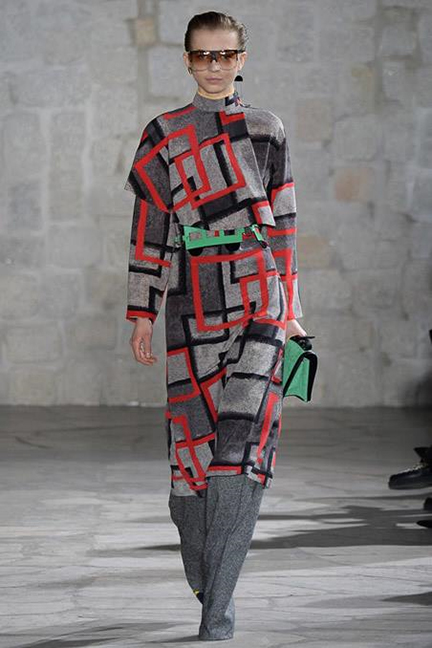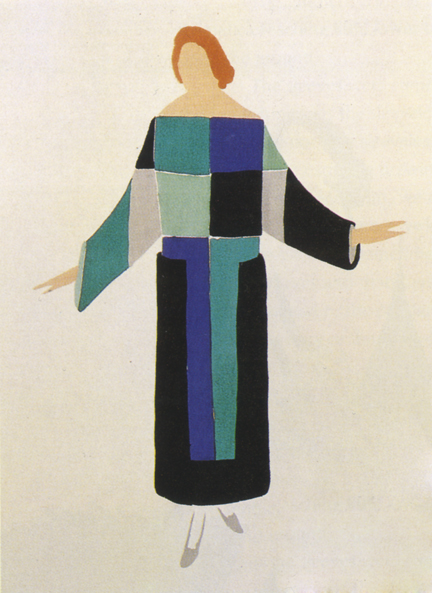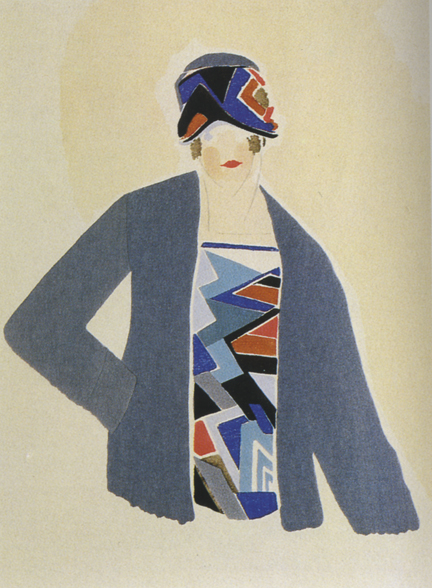 Charles and Ray Eames’ home succinctly decorated with squares and primary colors. Functional, modernist, and supremely American (and unsurprisingly, not without help from the Dutch).
Charles and Ray Eames’ home succinctly decorated with squares and primary colors. Functional, modernist, and supremely American (and unsurprisingly, not without help from the Dutch).
 Sketch for a leather coat by Bonnie Cashin, a simple design insisting that life is embellished enough, so much so that one’s clothes don’t need to be either.
Sketch for a leather coat by Bonnie Cashin, a simple design insisting that life is embellished enough, so much so that one’s clothes don’t need to be either.
 The illustrations for two designs by Charles Kleibacker highlight his strict application of geometry to female anatomy, suggesting that such a direct design concept is, in and of itself, all that is really necessary.
The illustrations for two designs by Charles Kleibacker highlight his strict application of geometry to female anatomy, suggesting that such a direct design concept is, in and of itself, all that is really necessary.
 An iconic Valentina image: perhaps no other couturier built such an elitist reputation by subscribing to the sparest sensibility – allowing the idea of exclusion in its purest form to dictate the aesthetic and the etiquette.
An iconic Valentina image: perhaps no other couturier built such an elitist reputation by subscribing to the sparest sensibility – allowing the idea of exclusion in its purest form to dictate the aesthetic and the etiquette.
While many collections took their cue from YSL’s romance and the exihibit of the designer’s work that was held at the Petite Palais – a perfectly reactionary move against overhyped “minimalism” – there were several designers who seemed to be genuinely interested in pursuing a calmer course. Maybe the term “minimalism” is a misnomer, it isn’t really about the “least possible”, is it? In the 90′s, designers stripped their clothes down to their most abstract forms, removing centuries of convention of what clothes are supposed to be and becoming a gateway for the rest of the industry (like most modernist aesthetics) into lazy design. But the collections from New York and Paris are very designed, with the rich fabrics and the luxurious details, there is nothing minimal about them. Maybe there is no noble philosophy behind them, they are not an ascetic grasp for purity, and maybe they are actually bit common at surface, but they are certainly easy to wear.
Historically it’s been an American tenet that clothes are to be designed with ease and practicality. No, Americans didn’t invent ready-to-wear or sportswear, but their predilection for them has pointed towards an unfettered design vocabulary and clothes that have no use for any excess concept. Beyond ruffles or eccentric prints, embroideries or gems, there are means for aesthetics inherent in clothes themselves, in their seams, the fabric, and in their application to everyday life. Minimal? Not exactly. Pragmatic? Absolutely. Maybe it is enough, more than enough, to dress a woman well.
 Spring 2011 looks by Celine, Chloe, Matthew Ames, Stella McCartney, Calvin Klein, and Band of Outsiders
Spring 2011 looks by Celine, Chloe, Matthew Ames, Stella McCartney, Calvin Klein, and Band of Outsiders
prag·ma·tism
noun \ˈprag-mə-ˌti-zəm\
Definition of PRAGMATISM
1
: a practical approach to problems and affairs
2
: an American movement in philosophy founded by C. S. Peirce and William James and marked by the doctrines that the meaning of conceptions is to be sought in their practical bearings, that the function of thought is to guide action, and that that truth is preeminently to be tested by the practical consequences of belief
– Merriam Webster dictionary
 Karl Lagerfeld with Ines de da Fressange wearing a dress by the designer for Chloe. Photograph by Pierre Vauthiey. Image originally published at fashionzizzle.com
Karl Lagerfeld with Ines de da Fressange wearing a dress by the designer for Chloe. Photograph by Pierre Vauthiey. Image originally published at fashionzizzle.com



















